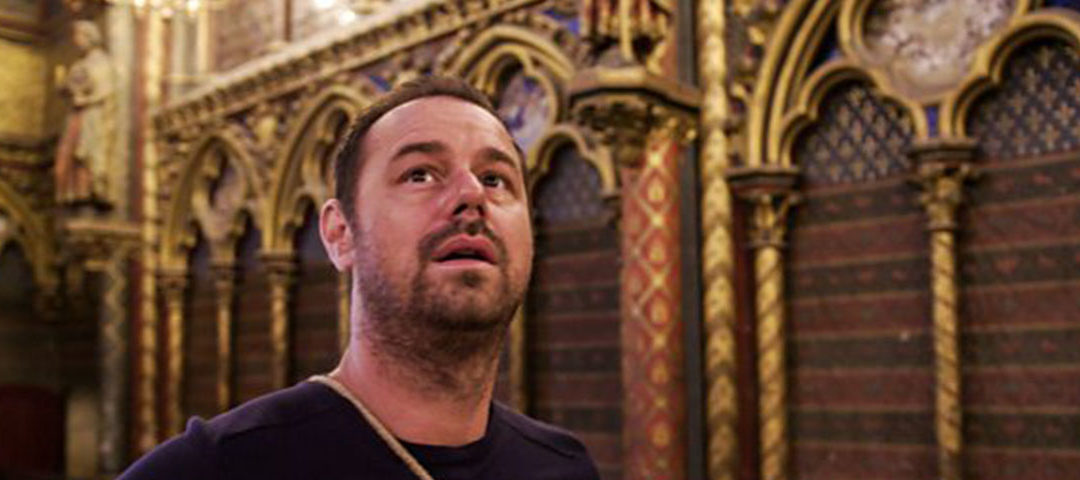This is the second of two recap reviews of Danny Dyer’s Right Royal Family. Read the recap of episode one.
By Paul Dryburgh, Principal Records Specialist, The National Archives
Readers, I have a confession to make. I have known for some days that I would be reviewing the second episode of Danny Dyer’s Right Royal Family. In that time, I have tried to reflect on the first episode, about which I posted on Tuesday, and assess what might have been done differently.
Perhaps inevitably given the subject matter of the programme and Danny’s mission to trace his family history, diversity and diverse histories have been wanting. This is one man’s journey that essentially explored great men in his lineage (we hardly knew ye in episode one, Empress Matilda), although the story was not solely of a political and military bent. Had I wished to have been disabused of this notion, however, I should have checked out the programme previews. My bad! Episode 2 introduces elements of gender and queer history framed around a more nuanced approach to masculinity. I wonder if you’d told Danny of this change in trajectory before he set out, he would have been any less keen. As it was, he embraced it wholeheartedly – ‘The first ’arf of this journey really ’as spun me nut. I’m sure there’s loads more to discover’. The producers exploited this gameness to take a more subdued Danny on an emotional roller coaster of discoveries revealed to him by another stellar cavalcade of professional historians whose expertise was conveyed with humour and pathos.
Having said that, if you thought the episode was more than a touch phallocentric, not to say phallo-obsessed, I would struggle to argue! If I had to describe this episode in one word, that word would be ‘smutty’ (‘phallo-obsessed’ being a word I’ve concocted for comic effect). And I loved it! The undoubted highlight of Danny’s two-hour clamber up his family tree was when he donned the luxurious clobber of Tudor courtier Sir John Seymour. In the setting of Wolfhall in Great Bedwyn, Wiltshire, Danny is stripped to his smalls by costume historian Professor Maria Hayward (‘Never wiv’ me socks on’) in order to try on hose, doublet, jewellery, hat, furs, the whole kit and caboodle. And by caboodle, I really mean the codpiece, a selection of which are laid out for Danny to road-test. The ensuing innuendo-laden but genuinely informative discussion of the social cachet of the codpiece in accentuating masculinity and enabling optimal peacocking provoked a magnificent series of withering expressions from Professor Hayward, of which Larry Grayson would have been proud, as Danny positioned his codpieces less than delicately on his groin for maximum adolescent comedic value. Mind you, her introduction to the caper had been prefaced by Danny in buttock-clenchingly awkward terms – ‘I’m gonna meet Maria who’s a dress historian. That’s a nutty job innit?’ This series has walked just the right side of the line of pricking the bubble of academic pomposity in a fashion more endearing than but not as satirically sharp as Dianne Morgan’s brilliant Cunk on Britain.
Dressed to the nines, Danny then experiences the perks of being a leading man in the Tudor social scene. Tutored by historical music expert Tamsin Lewis and dance practitioner Charlotte Ewart, Danny becomes the beau of the ball. ‘Let’s get the treacles in’, announces Danny before prancing around with costumed interpreters. Any embarrassment he felt is well disguised as his tutors reveal to him, and to us, the importance of athleticism, rhythm and social graces at court. Food historian Dr Annie Gray then guides Danny through the excesses of Tudor culinary hospitality. Far from the meaty gluttony Danny (and no doubt most in the audience) anticipates, he is treated to a sugar banquet, designed to grab attention. If it weren’t for the dental calamity that would undoubtedly follow, I would love to employ Dr Gray to be the sole caterer for my imagined future wedding!
Sir John Seymour is the final male member of his illustrious lineage that Danny traces. The episode kicks off as Danny puts his trotters on my manor. My doctoral thesis was on Roger Mortimer, putative lover of Queen Isabella, wife of Danny’s 23-times great-grandfather King Edward II, the man who with the queen orchestrated Edward’s downfall, deposition and possibly his murder (of which more shortly). The decision of how to treat one of England’s most notoriously poor monarchs whose alleged fate is even more notorious proved a fascination for me. The producers couldn’t resist the temptation to frame the story as a ‘mad medieval soap opera’. This, of course, undersells reality. Not even Den and Angie get close to Edward and Isabella! They have long been portrayed as, to quote Elizabeth Norton, ‘the most dysfunctional couple you can imagine’. Nevertheless, the issue of Edward’s personality and sexuality and their effects on his kingship is not ducked, although we are perhaps presented with too straightforward a tale.
Edward’s predilection for ‘rustic pursuits’ and ‘mechanical arts’ – hedging, ditching, rowing, carpentry – is well evidenced by narrative and record sources, as is his enjoyment of the company of lowborn subjects. Given an insight into this facet of Edward’s personality, his love of ‘unkingly’ pursuits including thatching, Danny spouts the line of the night – ‘Imagine tellin’ your neighbours “Yeh, the king fatched my roof”. No one wud ’av it. They’d go “Oh, shaaat aap!”’
It is when we turn to more in-depth discussion of the king and queen’s relationship that Danny is more reflective. In a scene that was a little out of place, Danny is confronted with an actress playing the part of Queen Isabella. Her hectoring, nagging caricature is out of step with the historical evidence and jarred with Danny’s subsequent monologue that Isabella is ‘the brainiest, cleverest woman in my family tree’. The scene is also used to broach the subject of the king’s sexuality:
‘Where’ve you been? Have you been out with Hugh Despenser? First it was Piers “bloody” Gaveston and now it’s Hugh. I’m gonna chop his bloody balls off. I loved you for ten long years and you only slept with me because you wanted an heir’.
I won’t dispute the possibility, even probability, of the horrific execution of Hugh Despenser the Younger (descriptions and depictions detail his castration – ‘ ’av they taken his winkle off?’), Edward’s most insidious and intelligent favourite, in November 1326, being motivated by accusations of a sodomitical relationship. But the marriage between Edward and Isabella had long been close and apparently loving. Their estrangement was caused not by her relationship with the political rebel and exile Roger Mortimer (‘Roger is more of a man than you’, screams the faux Isabella. ‘Roger? We’re just pals’, replies a bemused Danny, assuming him to be another gay lover of the king. ‘Ooz Roger?’) Edward’s implacable unwillingness to cast off men in whom he put his personal trust despite the difficulties this caused with the noble community that constituted his traditional counsel proved irredeemable.
Perspective is provided by Professor Chris Given-Wilson, one of Britain’s greatest medieval historians, author of the superb Penguin Monarchs biography of Edward II, and another recipient, this time at the ‘quite camp’ Berkeley Castle in Gloucestershire, of an epic Dyer man-hug. Edward’s possible homosexuality was not the prime cause for his vilification: ‘What really mattered was the intensity and the exclusivity of those relationships’. This encapsulates perfectly the relationships between Edward and his intimates and gives context to Edward’s fate after his deposition / abdication in January 1327. Set in the cell at Berkeley in which Edward is thought to have been held captive from April-September 1327, Chris and Danny then pore over the infamous text adopted by several near-contemporary writers as well as Derek Jarman in his retelling of Christopher Marlowe’s tragedy, which describes in horrific detail the murder by insertion of a red-hot iron into Edward’s bowels. Of course, this reflects the queering of Edward during and after his lifetime, and the programme dealt with the tale without giving it the credence it no longer deserves. What the programme makers do not do, consciously or otherwise, is engage with modern debates about the possible survival of the late king that viewers might perhaps have found interesting. Moved by his ancestor’s fate, though, Danny shows his pride: ‘Edward was committed to the man he was born to be … I ’ope he was gay’.
This more sombre, empathetic side to our star is soon channelled more aggressively as he dons full plate armour to battle Dr Tobias Capwell, one of the country’s leading experts in armour and weaponry, while examining the martial prowess of Henry Percy, ‘Hotspur’. As in episode one, this cleverly brings home to Danny the practical difficulties in vision, manoeuvrability and ambition in combat – ‘It’s like wearing another man … I can’t wait to take it off and put me chinos on’.
And this, for me at least, is one of the triumphs of the series. The producers and star, aided by experts with a real sense of humour, present history as something in which anyone could find something to interest them without ever taking itself too seriously. History presented to a mass audience doesn’t have to be wedded to any one approach. It also doesn’t have to be presented as objective ‘truth’ to educate, inform and move people, and a more ‘popular’ approach such as this should not per se be cause for academic hand-wringing or navel-gazing.
But what of Danny Dyer? There can be little doubt that this was a profitable journey, both in terms of rooting him in a purple-blooded lineage and for his bank balance. At the conclusion of the show he gathers his wife and children around him. They rib him gently for his poor biological luck not to have grown up in such splendour (as well as shockingly misquoting Jim Bowen and Ted Rogers – that’s what YouTube is for, kids!). Danny Dyer is not everyone’s cup of tea but as a vehicle for communicating history in an entertaining and informative manner he is eminently successful.

Paul Dryburgh is Principal Records Specialist at The National Archives. Follow him for Right Royal updates, references to 1970s and 1980s comedians, and more on Twitter @pablodiablo74

